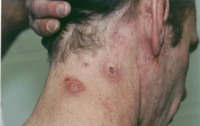Staph infections spreads in poor Chicago neighborhoods
Drug-resistant staph infections have spread to the urban poor, rising almost seven-fold in recent years in some Chicago neighborhoods.

Researchers said the crowded living conditions of public housing and jails may speed up the person-to-person spread of infection.
The superbugs, first seen mainly in hospitals and nursing homes, have turned up recently among athletes, prisoners and people who get illegal tattoos.
Called methicillin-resistant staphylococcus aureus, or MRSA, these staph germs can cause skin infections that in rare cases have led to pneumonia, bloodstream infections and a painful, flesh-destroying condition. MRSA is hard to treat because the bacteria have developed resistance to the penicillin drug family.
From 2000 to 2005, the infection rate seen in patients seeking care at Chicago's main public hospital and its affiliated clinics climbed from 24 cases per 100,000 to 164 cases per 100,000, the study found.
Dr. Bala Hota of Chicago's Stroger Hospital, a lead author of the study, said the increase is similar to that seen in other cities.
Public housing could be a bridge between high-risk people, the researchers wrote in their study, which appears in Monday's Archives of Internal Medicine.
Dr. Susan Gerber of Chicago's Department of Public Health said it would be a mistake to assume the infection isn't also in affluent neighborhoods. The study looked only at people using the public hospital system. The infection rate in the general population is unknown.
"This is an equal opportunity bacteria," Gerber said.
To prevent staph's spread, the U.S. Centers for Disease Control and Prevention recommends washing hands with soap and water or an alcohol-based sanitizer, keeping cuts clean and covered with a clean bandage until healed, avoiding contact with other people's wounds and bandages and avoiding shared personal items such as towels and razors.
Subscribe to Pravda.Ru Telegram channel, Facebook, RSS!





